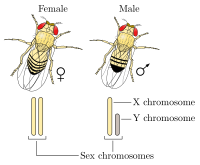
Photo from wikipedia
XY C57BL/6J (B6) mice harboring a Mus musculus domesticus-type Y chromosome (YPOS), known as B6.YPOS mice, commonly undergo gonadal sex reversal and develop as phenotypic females. In a minority of… Click to show full abstract
XY C57BL/6J (B6) mice harboring a Mus musculus domesticus-type Y chromosome (YPOS), known as B6.YPOS mice, commonly undergo gonadal sex reversal and develop as phenotypic females. In a minority of cases, B6.YPOS males are identified and a proportion of these are fertile. This phenotypic variability on a congenic B6 background has puzzled geneticists for decades. Recently, a B6.YPOS colony was shown to carry a non-B6-derived region of chromosome 11 that protected against B6.YPOS sex reversal. Here. we show that a B6.YPOS colony bred and archived at the MRC Harwell Institute lacks the chromosome 11 modifier but instead harbors an ∼37 Mb region containing non-B6-derived segments on chromosome 13. This region, which we call Mod13, protects against B6.YPOS sex reversal in a proportion of heterozygous animals through its positive and negative effects on gene expression during primary sex determination. We discuss Mod13's influence on the testis determination process and its possible origin in light of sequence similarities to that region in other mouse genomes. Our data reveal that the B6.YPOS sex reversal phenomenon is genetically complex and the explanation of observed phenotypic variability is likely dependent on the breeding history of any local colony.
Journal Title: Genetics
Year Published: 2020
Link to full text (if available)
Share on Social Media: Sign Up to like & get
recommendations!